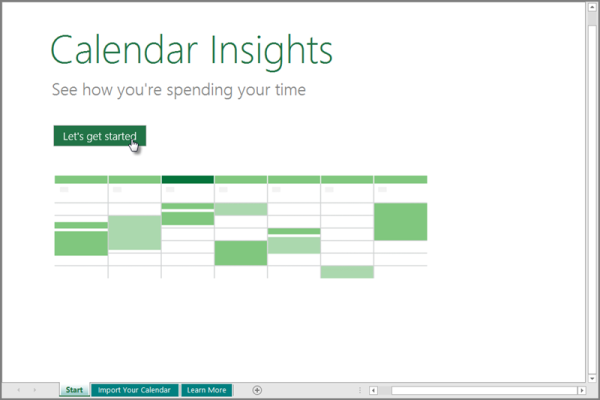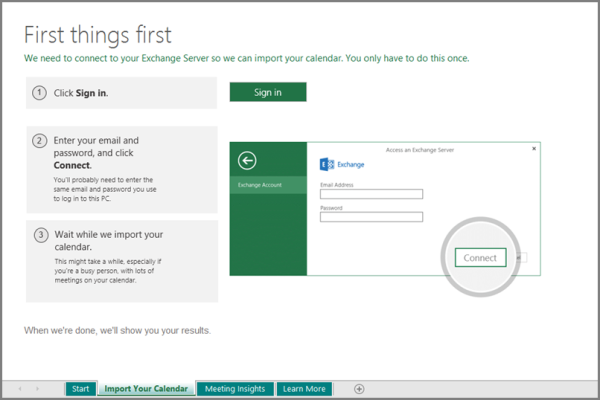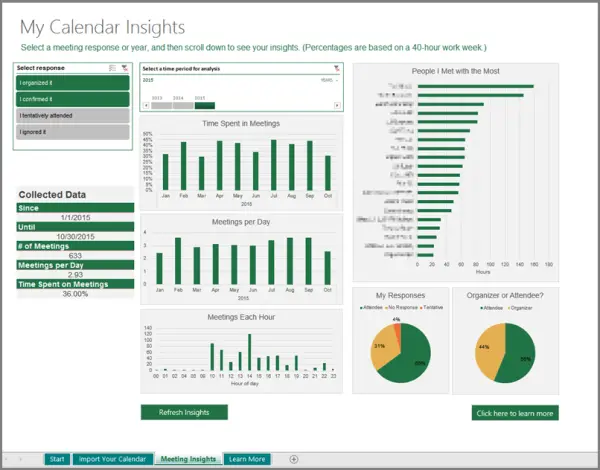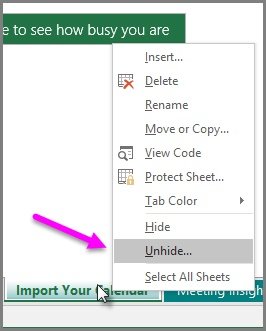One visible change that you will observe in Excel in comparison to its earlier versions is the addition of a new template called Calendar Insights. The template displays a detailed record of how much time you spend in meetings, whom you meet with the most, and which part of the day you find most appropriate to meet the people. You can find your calendar in the form of a dashboard and begin interacting from there. So, in this post, let’s see how to Open the Calendar Insights workbook with your data in Excel.

How to save Calendar Insights in Excel
Open Excel and search for the Calendar Insights template.
Now, to access your calendar using the template, you need an active account on an Exchange Server, or on Exchange Online as part of your Office 365 subscription.
If your account is active, select New in Excel and navigate the cursor to ‘Calendar Insights’.
If you have any difficulty finding the template, use the search box of the application and type calendar insights. The Calendar Insights template should appear on completion of the action.
Open the template and you should see the first workbook tab, titled Start. Select the Let’s Get Started button to begin.

Towards the bottom, you will see the ‘Import Your Calendar tab is selected’, providing steps about how to connect to the Exchange Server and import your calendar.
Hit the Sign-in button! When you do this, the Excel app will display a dialog that requests the user to enter an email address and password so the app can connect to your Exchange Server and load your calendar information into the workbook.

Once complete, the Meeting Insights worksheet appears and shows a populated dashboard that features a collection of detailed analytics based on your calendar.

To save the Calendar Insights workbook with your data as a macro-enabled workbook, do the following:
Select File, scroll down to locate ‘Save As’ option. Hit the button.
Next, select a destination and choose Excel Macro-Enabled Workbook in the Save as type drop-down menu. Saving the workbook as a macro-enabled workbook ensures that all charts are updated automatically when you select the Refresh Insights button on the Meeting Insights worksheet.

Finally, if you require any data from your calendar, open the workbook and select the Refresh Insights button at the bottom of the Meeting Insights worksheet.
Customize Calendar Insights template in Excel
Calendar Insights template in Excel is a professionally designed and easy-to-use template that can help you plan and schedule your meetings. Originally designed for accounting purposes, the Excel App has come a long way and has turned into one of the most popular tools for creating custom calendars. Earlier above, we covered how to save the Calendar Insights Workbook in Excel. Going a step further, we now learn the method to customize calendar insights templates on your Windows computer.
An Excel user can customize the template to meet his specific working requirements and alter the calculation of the time spent on meetings by following the below-mentioned steps.
Open the Excel workbook. Next, right-click a worksheet tab, and select Unhide… for the menu that appears.

Thereafter, select the Parameters sheet from the Unhide window that pops up on your computer screen, and select OK. In the Unhide window, only worksheets that are hidden are displayed.
Now, choose the Parameters worksheet, and customize the values in the table as desired. Here, you can change the following values.

- Hours of work per day – Select any value between 1 to 24 to alter the parameter.
- Days of work per week – Allows a user to set any value between 1 to 7.
- Ignore long meetings (hours) – Trainings can be long and can extend from a few minutes to many hours. So, if you have meetings longer than 4 hours that you want to include in calculations, you can increase this parameter.
It is important to mention here that if you edit any of the values on the Parameters worksheet, you will need to refresh the workbook.
For doing this, simply select Data > Refresh All. The action, when confirmed, will allow new values to take effect. That’s all to it! This way, you can customize the calendar Insights template in Excel.
I hope you find this tip useful.